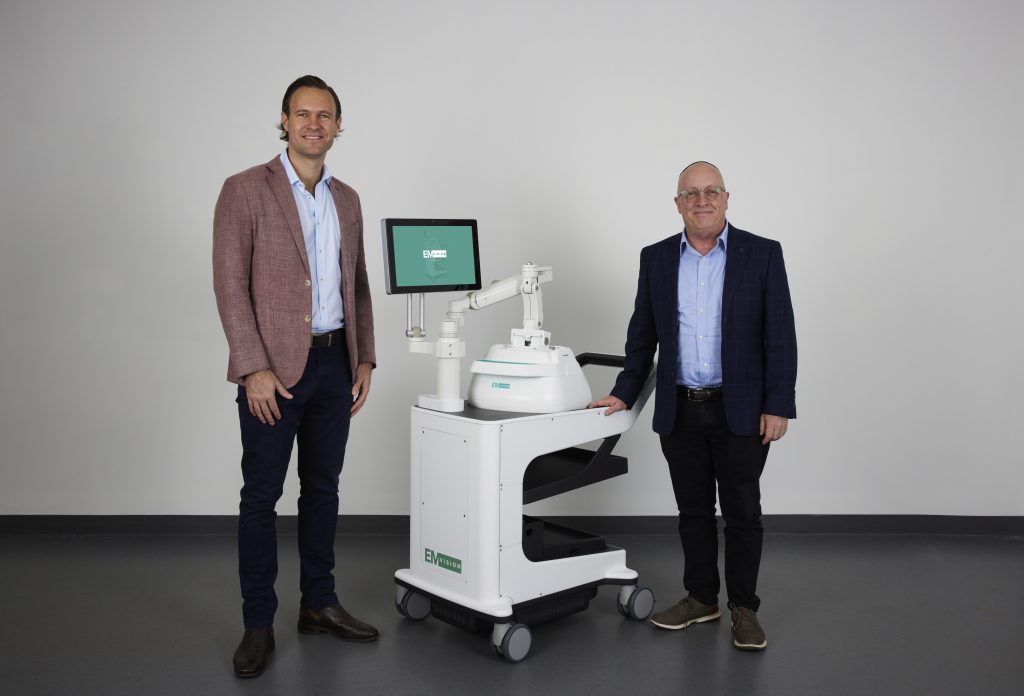Faster stroke detection with world-first portable brain scanners
By bringing brain-scanning to the patient, these novel neuroimaging devices will help to substantially speed up stroke diagnosis and treatment.
Every two seconds someone in the world experiences a stroke. To minimise oxygen deprivation, each minute counts. “Receiving treatment immediately is critical because a stroke can kill 1.9 million brain cells per minute,” says Kelvin Hill, Stroke Foundation, National Manager of Treatment. Enter portable neuroimaging technology, designed to transform the landscape of stroke diagnosis, particularly within the critical “golden hour” when more brain tissue can be conserved. “All suspected stroke patients need a brain scan before commencing treatment, as protocols differ for haemorrhagic strokes caused by bleeding and ischeaemic strokes, caused by clots,” says Hill. “Portable brain scanning devices enable earlier information to better direct care and more rapid treatment. This is exactly the ground-breaking change we need in stroke care.”
Recognising this vital importance, NSW Health has provided development assistance for these world-first brain-scanning devices via a Medical Devices Fund grant of $2,500,000 from the Office For Health and Medical Research (OHMR). Beneficial connections were also fostered through OHMR, which supports the research, development, translation and commercialisation of medical devices like these. OHMR often provides this support through the Medical Devices Fund, or by facilitating international connections and partnerships, which recently occurred in collaboration with Investment NSW during the 29th NSW-Guangdong Joint Economic Meeting (JEM) in September. JEM provides a framework for NSW to explore health and life sciences opportunities of mutual interest to Guangdong, as part of an ongoing 44-year Sister State relationship. This year’s Joint Economic Meeting saw over 70 leaders from NSW and Guangdong health and life sciences sectors come together. The meeting provided an opportunity to showcase the NSW health and medical research ecosystem, and hear from some of our distinguished researchers.

Bringing stroke scanning to the patient
While CT and MRI brain scans produce excellent images, they have some limitations. “These standard of care machines are complex and stationary and require specialist operators – all factors that limit their point-of-care accessibility,” explains Scott Kirkland, Co-Founder and CEO of EMVision Medical Devices Ltd, which was formed in 2017, to bring the company’s two novel portable electromagnetic brain-scanning devices to market. “Globally, there are around 15 million strokes a year,” says Kirkland. “Only about one in ten receive treatment. The limitations of conventional scanning can lead to a delay in access and diagnosis in the event of a stroke. After treatment and intervention, they are not devices that can be used for frequent bedside monitoring to keep a close eye on the patient. In both cases, urgent brain imaging is required before the correct triage, transfer, treatment or intervention decision can be made.”
Australia’s world-first portable neuro-imagining EMVision scanners, have been designed to address this unmet need. They promise to revolutionise on-the-spot stroke response and treatment for Australians everywhere, whether patients are in hospital, at home, or in an ambulance. “One in four adults will have a stroke in their lifetime,” says Kirkland. “Currently two out of three strokes result in permanent disability and we are hoping our devices will help improve these stroke outcomes.” Hill echoes these sentiments. “We are very keen to see these innovations being commercialised as they have high potential to help more people survive a stroke and live well and independently after a stroke event.”
World-first bedside and ambulance brain scanners
EMVision’s two different portable brain imaging devices have evolved over a decade of advanced imaging research by leading electromagnetic imaging experts at the University of Queensland and a talented engineering team in their Macquarie Park HQ. Both their devices use non-ionising ultra-high frequency radio signals, so they require no special shielding and no invasive procedures, such as injecting contrast agents to increase the clarity of the image. Instead, they use a ring of proprietary antennas around the head to deliver pulses of low-power radio signals to generate a picture of the brain and determine the type of stroke.
The first-generation EMVision device is world-first bedside imaging equipment which can be utilised in hospital or the home. Like a cart ultrasound, it is easy to store and wheel in to place. The 2nd generation device looks like a large helmet and is designed to be carried in standard road and air ambulances to deliver pre-hospital stroke diagnosis to patients in any geographical location. “In a matter of minutes, our portable brain scanners will generate quality images for pre-hospital and bedside assessment to distinguish between an ischaemic and haemorrhagic stroke,” says Kirkland. “This information will help ensure that the patient receives targeted treatment as soon as possible and assist in decision making about whether to transfer the patient to a specialist clot retrieval centre or nearest hospital.”
Rapid diagnosis to fast-track stroke treatment can profoundly improve a person’s future health and quality of life after a stroke event. “For every 15 minutes saved restoring blood flow to the brain, one month of healthy life is gained,” says Hill. “Studies also show that applying thrombolysis 15 minutes faster (to break up blood clots or prevent new ones from forming), can lead to a reduction in disability and lower mortality in hospital and can increase the number of patients walking independently when they go home.”
Further benefits of brain scanning on-the-spot
Portable neuro-imaging devices will be particularly beneficial in areas where patients who experience a stroke have less access to specialized medical equipment and care. “In regional, rural and remote areas, where over a quarter of our population resides, patients may have to travel hundreds of kilometres to access stroke care and today only around 3 % of people are treated in stroke units, compared to 77% of patients treated in stroke units in metropolitan areas,” says Kirkland. “So, bringing the brain scanner to the patient will help ensure faster, more accessible treatment that will reduce disability and help save lives.”
Reduced transport costs and shorter admission times in hospitals are just some of the potential additional perks. “As well as being used for stroke victims, our devices have the potential to be used in assessing mild, moderate and severe, traumatic brain injury, in any
environments where access to CT/MRI is limited or not practical” Kirkland confirms. A successful proof-of-principle study at Brisbane’s Princess Alexandra hospital in 2020-21 confirmed that the devices have the ability to distinguish between ischemic and intracerebral haemorrhage and stroke location within a given brain quadrant. Further multi-centre clinical trials in NSW, VIC and QLD are now underway to support the regulatory pathway.
Updated 5 months ago
